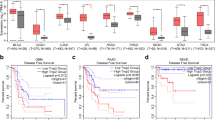Abstract
The present study was designed to unravel the bioevaluation of [99mTc]Tc-GSH in HT 29 colon cancer cell line as well as in experimentally induced colon cancer. The radiochemical yield was observed to be 95.93 ± 1.09%. In silico docking studies revealed that [99mTc]Tc-GSH gets well accommodated in the binding pocket of gamma-glutamyl transpeptidase in comparable orientation with lowest estimated binding energy − 81.90. Toxicity assays i.e. 3-(4,5-dimethylthiazolyl-2)-2,5-diphenyltetrazolium bromide and trypan blue exclusion assay showed that radiocomplex is non-toxic to HT 29 cells. In conclusion, in vitro and in vivo results indicated the [99mTc]Tc-GSH radiocomplex has tumor delineating features and also exhibits selectivity for colon tumor.


















Similar content being viewed by others
References
Gulam W, Haseeb A (2006) Reactive oxygen species: role in the development of cancer and various chronic conditions. J Carcinogen 5:14
Demple B, Harrison L (1994) Repair of oxidative damage to DNA: enzymology and biology. Annu Rev Biochem 63:915–948
Moller P, Wallin H (1998) Adduct formation, mutagenesis and nucleotide excision repair of DNA damage produced by reactive oxygen species and lipid peroxidation product. Mutat Res 410:271–290
Shigenaga MK, Hagen TM, Ames BN (1994) Oxidative damage and mitochondrial decay in aging. Proc Natl Acad Sci USA 91:10771–10778
Ames BN, Shigenaga MK, Hagen TM (1993) Oxidants, antioxidants, and the degenerative diseases of aging. Proc Natl Acad Sci USA 90:7915–7922
Olinski R, Zastawny T, Budzbon J, Skokowski J, Zegarski W, Dizdaroglu M (1992) DNA base modifications in chromatin of human cancerous tissues. FEBS Lett 309:193–198
A Bansal, CM Simon (2018) Glutathione metabolism in cancer progression and treatment resistance. J Cell Biol 217(7):2291–2298
Gupta RK, Patel AK, Shah N, Chaudhary AK, Jha UK, Yadav UC, Gupta PK, Pakuwal U (2014) Oxidative stress and antioxidants in disease and cancer: a review. Asian Pac J Cancer Prev 15:4405–4409
Toyokuni S, Okamoto K, Yodoi J, Hiai H (1995) Persistent oxidative stress in cancer. FEBS Lett 358:1–3
Reuter S, Gupta SC, Chaturvedi MM, Aggarwal BB (2010) Oxidative stress, inflammation, and cancer: How are they linked? Free Radical Biol Med 49:1603–1616
Meister A (1995) Glutathione metabolism. Methods in Enzymol 251:3–7
Sies H (1999) Glutathione and its role in cellular functions. Free Rad Biol Med 27:916–921
Wu G, Fang YZ, Yang S, Lupton JR, Turner ND (2004) Glutathione metabolism and its implications for health. J Nutr 134:489–492
Gottesman MM, Fojo T, Bates SE (2002) Multidrug resistance in cancer: role of atp-dependent transporters. Nat Rev Cancer 2:48–58
Kaplowitz N, Aw TY, Ookhtens M (1985) The regulation of hepatic glutathione. Ann Rev Pharmacol Toxicol 25:715–744
Zhang H, Forman HJ (2009) Redox regulation of gamma glutamyl transpeptidase. Am J Respir Cell Mol Biol 41:509–515
Corti A, Franzini M, Paolicchi A, Pompella A (2010) Gamma-glutamyl transferase of cancer cells at the crossroads of tumor progression, drug resistance and drug targeting. Anticancer Res 30:1169–1181
Bowen M, Orvig C (2008) 99 m-technetium carbohydrate conjugates as potential agents in molecular imaging. Chem Commun 41:5077–5091
Wongso H, Zainuddin N, Iswahyudi I (2013) Biodistribution and imaging of 99mTc-glutathione radiopharmaceutical in white rats induced with cancer. Atom Indonesia 39(3):106–111
Khurana H, Meena VK, Prakash S, Chuttani K, Chadha N, Jaswal A, Dhawan DK, Mishra AK, Hazari PP (2015) Preclinical evaluation of a potential GSH ester based PET/SPECT imaging probe DT(GSHMe)2 to detect Gamma Glutamyl Transferase over expressing tumors. PLoS ONE 10(7):e0134281
Sadeghpour H, Alavi M, Shahedi M, Entezarmahdi SM, Sakhteman A, Kowalsky RJ, Falen SW (2014) Evaluation of radiochemical purities of some radiopharmaceuticals in Shiraz Namazi Teaching Hospital. Trends Pharmacol Sci 1(1):10–14
Zolle I (ed) (2007) 99mTc-phramaceutical preparation and quality control in nuclear medicine. ISBN-13: 978-3-540-33989-2$4. Springer, Berlin
Pyka AL, Babuska M, Zachariasz MA (2006) A comparison of theoretical methods of calculation of partition coefficients for selected drugs. Acta poloniae pharmaceutica-Drug Res 63:159–167
Chadha VD, Goel, Dhawan DK (2011) Regulatory role of Zinc on the Biokinetics and Biodistribution of 65Zn during the Initiation of experimentally induced Colon cancer. Nutr Cancer 63(2):212–221
Priyadarshani A, Chuttani K, Mittal G, Bhatnagar A (2010) Radiolabeling, biodistribution and gamma scintigraphy of noscapine hydrochloride in normal and polycystic ovary induced rats. J Ovarian Res 3:1–8
Kumar RR, Dhawan DK, Chadha VD (2019) Development and initial characterization of 99mTc labeled N-acetyl neuraminic acid for its application in in-vivo imaging of cancer: a preclinical study. J Radioanal Nucl Chem 322:533–543
Baba K, Moretti JL, Weinmann P, Senekowitsch-Schmidtke R, Ercan MT (1999) Tc-Glutathione Complex (Tc-GSH): labelling, chemical characterization and biodistribution in rats. Met-Based Drugs 6:865149
Ercan MT, Bekdik CF, Sarizi T (1978) 99mTc-glutathione: labelling and distributionin rats. Int J Appl Rad Isot 29:697–698
Saha GB (1996) The chemistry of Tc-99m-labeled radiopharmaceuticals. Albuq New Mexico 5:1
Dalhoff D, Ranek L, Mantoni M, Poulsen HE (1992) Glutathione treatment of hepatocellular carcinoma. Liver 12:341–343
Author information
Authors and Affiliations
Corresponding author
Additional information
Publisher's Note
Springer Nature remains neutral with regard to jurisdictional claims in published maps and institutional affiliations.
Rights and permissions
About this article
Cite this article
Sidiq, S., Kumar, R.R., Passi, N.D. et al. Evaluation of 99mTc-labeled glutathione as a colon cancer targeting probe. J Radioanal Nucl Chem 327, 673–689 (2021). https://doi.org/10.1007/s10967-020-07563-1
Received:
Accepted:
Published:
Issue Date:
DOI: https://doi.org/10.1007/s10967-020-07563-1




